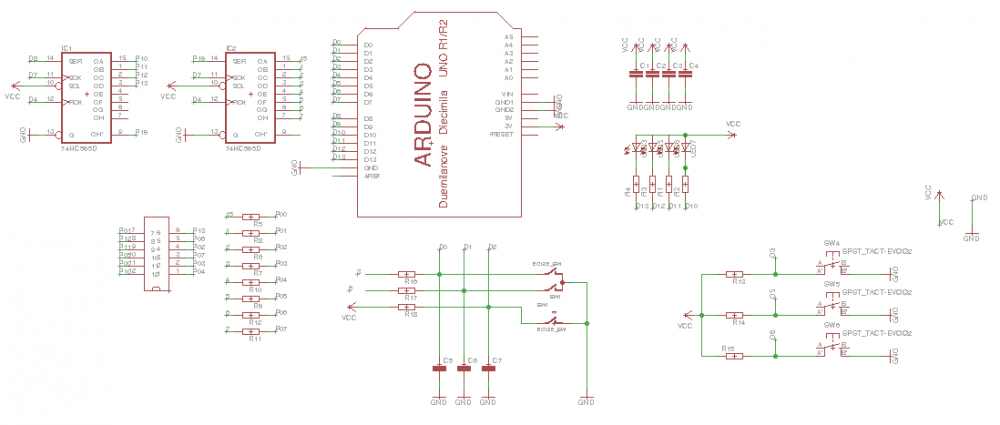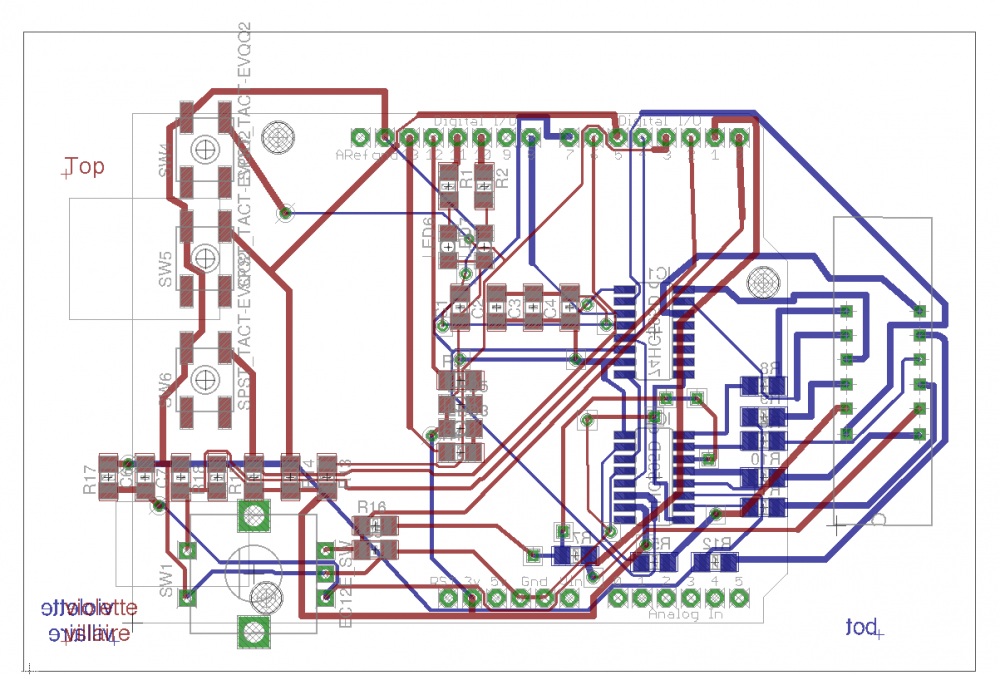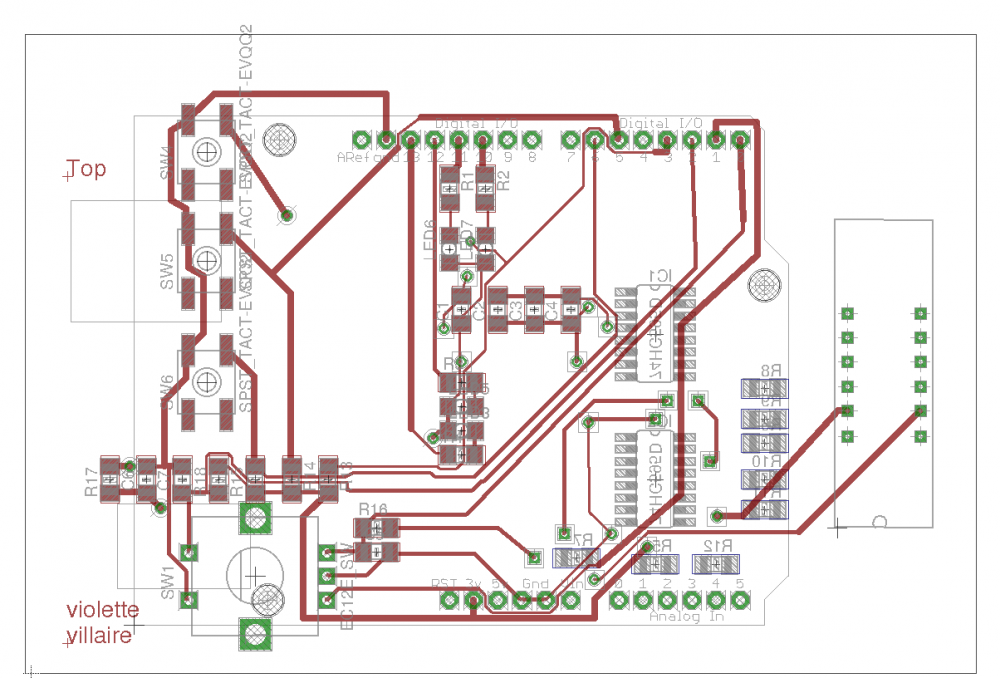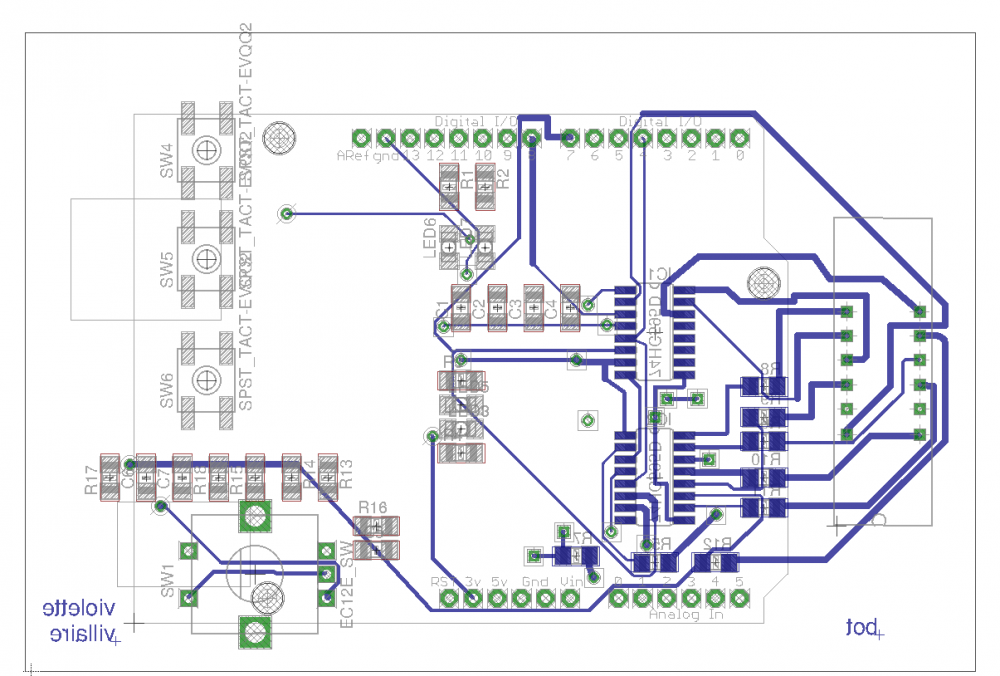De0NanoExtension : Différence entre versions
| Ligne 3 : | Ligne 3 : | ||
==={{Vert|Présentation du projet}}=== | ==={{Vert|Présentation du projet}}=== | ||
Le but de ce projet est de réaliser un shield multifonction, généraliste, sur une De0Nano. Les composants qui vont être utilisés sont un afficheur 4x7 segments, un bouton à codage rotatif, 2 registres à décalage (74HC595), des boutons poussoirs et des leds. | Le but de ce projet est de réaliser un shield multifonction, généraliste, sur une De0Nano. Les composants qui vont être utilisés sont un afficheur 4x7 segments, un bouton à codage rotatif, 2 registres à décalage (74HC595), des boutons poussoirs et des leds. | ||
| − | + | [[Fichier:Sg|100px|link=Fichier:Scg]] | |
==={{Vert|Conception du schéma Eagle}}=== | ==={{Vert|Conception du schéma Eagle}}=== | ||
[[Fichier:Schéma Eagle.png|1000px|link=Fichier:Schéma Eagle.png]] | [[Fichier:Schéma Eagle.png|1000px|link=Fichier:Schéma Eagle.png]] | ||
Version du 19 janvier 2017 à 15:36
Sommaire
Projet carte extension pour DE0Nano 2016/2017 (Violette et Villaire)
Première Partie : Étude théorique
Présentation du projet
Le but de ce projet est de réaliser un shield multifonction, généraliste, sur une De0Nano. Les composants qui vont être utilisés sont un afficheur 4x7 segments, un bouton à codage rotatif, 2 registres à décalage (74HC595), des boutons poussoirs et des leds. 100px
Conception du schéma Eagle
Conception du routage Eagle
Modèle:Routage complet
Modèle:Routage de la face Top
Modèle:Routage de la face Bot
Deuxième Partie : Réalisation de la carte
Troisième Partie : Test de la carte
Test des leds
const int L1 = 10; //Déclaration des broches
const int L2 = 11;
const int L3 = 12;
const int L4 = 13;
void setup()
{
pinMode(L1, OUTPUT); //Les broches sont des broches de sortie
pinMode(L2, OUTPUT);
pinMode(L3, OUTPUT);
pinMode(L4, OUTPUT);
}
void loop()
{
digitalWrite(L1, HIGH); //Toutes les leds s'allument pendant 1 seconde
digitalWrite(L2, HIGH);
digitalWrite(L3, HIGH);
digitalWrite(L4, HIGH);
delay(1000);
digitalWrite(L1, LOW);
digitalWrite(L2, LOW);
digitalWrite(L3, LOW);
digitalWrite(L4, LOW);
delay(1000);
}
Test des boutons poussoirs
int pinBouton;
int pinBouton2;
int pinBouton3;
int pinLed1, pinLed2, pinLed3; //Déclaration des variables
void setup()
{
pinBouton = 3;
pinBouton2 = 5;
pinBouton3 = 6;
pinLed1 = 10;
pinLed2 = 11;
pinLed3 = 12; //Initialisation des variables
pinMode(pinBouton, INPUT); //Mode lecture pour les boutons
pinMode(pinBouton2, INPUT);
pinMode(pinBouton3, INPUT);
pinMode(pinLed1, OUTPUT); //Mode écriture pour les leds
pinMode(pinLed2, OUTPUT);
pinMode(pinLed3, OUTPUT);
}
void loop()
{
boolean etatBouton = digitalRead(pinBouton);
boolean etatBouton2 = digitalRead(pinBouton2);
boolean etatBouton3 = digitalRead(pinBouton3); //Lecture de l'état du bouton et stockage dans etatBouton
if (etatBouton==LOW) //Test si bouton appuyé
{
digitalWrite(pinLed1,LOW); //led1 allumée
digitalWrite(pinLed2,HIGH); //led2 éteinte
digitalWrite(pinLed3,HIGH);//led3 éteinte
}
if (etatBouton2==LOW) //Test si bouton2 appuyé
{
digitalWrite(pinLed1,HIGH); //led1 éteinte
digitalWrite(pinLed2,LOW); //led2 allumée
digitalWrite(pinLed3,HIGH);//led3 éteinte
}
if (etatBouton3==LOW) //Test si bouton3 appuyé
{
digitalWrite(pinLed1,HIGH); //led1 éteinte
digitalWrite(pinLed2,HIGH);//led2 éteinte
digitalWrite(pinLed3,LOW);//led3 allumée
}
}
Quatrième Partie : Réalisation d'un programme
Nous avons décidé de tester la carte avec une carte Arduino UNO. Le programme utilisé est :
/* Define shift register pins used for seven segment display */
#define LATCH_DIO 4
#define CLK_DIO 7
#define DATA_DIO 8
/* Segment byte maps for numbers 0 to 9 */
const byte SEGMENT_MAP[] = {
0xC0,0xF9,0xA4,0xB0,0x99,0x92,0x82,0xF8,0X80,0X90};
/* Byte maps to select digit 1 to 4 */
const byte SEGMENT_SELECT[] = {0xF1,0xF2,0xF4,0xF8};
byte x=0;
byte x1=0;
byte x2=0;
byte x3=0;
#define PinA 1 // 1ere sortie du codeur
#define PinB 0 // 2e sortie du codeur
volatile boolean mouvement;
volatile boolean up;
unsigned int valeur = 0;
// routine déclanchée quand le signal A passe de haut a bas
void setup ()
{
/* Set DIO pins to outputs */
pinMode(LATCH_DIO,OUTPUT);
pinMode(CLK_DIO,OUTPUT);
pinMode(DATA_DIO,OUTPUT);
pinMode(PinA,INPUT);
pinMode(PinB,INPUT);
// activation des pullups internes de l'Arduino, si on n'utilise pas de pullups externes.
// digitalWrite (PinA, HIGH);
// digitalWrite (PinB, HIGH);
attachInterrupt (0,routineInterruption,FALLING); // interruption sur front descendant
Serial.begin (9600); // initialisation du moniteur série
Serial.println("Veuillez tourner le bouton");
}
void routineInterruption () {
//if (digitalRead(PinA))
up = digitalRead(PinA);
// else
// up = !digitalRead(PinB);
mouvement = true;
}
/* Main program */
void loop()
{
/* Update the display with the current counter value */
if (mouvement) { // on a détecté une rotation du bouton
if (up)
//valeur++;
incrementBCD(&valeur);
else
//valeur--;
decrementBCD(&valeur);
mouvement= false;
Serial.println (valeur);
}
WriteNumberToSegment(0 , (valeur&0xF000)>>12);
delay(1);
WriteNumberToSegment(1 , (valeur&0x0F00)>>8);
delay(1);
WriteNumberToSegment(2 , (valeur&0x00F0)>>4);
delay(1);
WriteNumberToSegment(3 , (valeur&0x000F));
delay(1);
}
/* Write a decimal number between 0 and 9 to one of the 4 digits of the display */
void WriteNumberToSegment(byte Segment, byte Value)
{
digitalWrite(LATCH_DIO,LOW);
shiftOut(DATA_DIO, CLK_DIO, MSBFIRST, SEGMENT_MAP[Value]);
shiftOut(DATA_DIO, CLK_DIO, MSBFIRST, SEGMENT_SELECT[Segment] );
digitalWrite(LATCH_DIO,HIGH);
}
void incrementBCD(unsigned int *cnt) {
(*cnt)++;
if ((*cnt & 0x000F) > 0x0009) *cnt += 6;
if ((*cnt & 0x00F0) > 0x0090) *cnt += 0x0060;
if ((*cnt & 0x0F00) > 0x0900) *cnt += 0x0600;
if ((*cnt & 0xF000) > 0x9000) *cnt += 0x6000;
}
void decrementBCD(unsigned int *cnt) {
(*cnt)--;
if ((*cnt & 0x000F) == 0x000F) *cnt -= 6;
if ((*cnt & 0x00F0) == 0x00F0) *cnt -= 0x0060;
if ((*cnt & 0x0F00) == 0x0F00) *cnt -= 0x0600;
if ((*cnt & 0xF000) == 0xF000) *cnt -= 0x6000;
}



